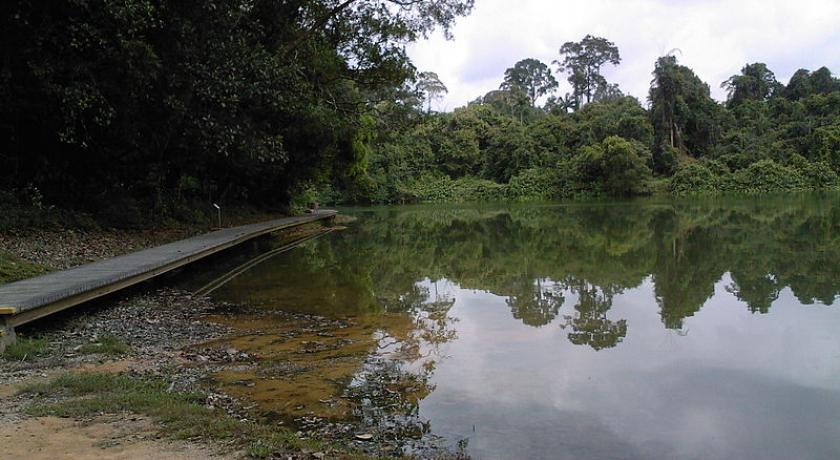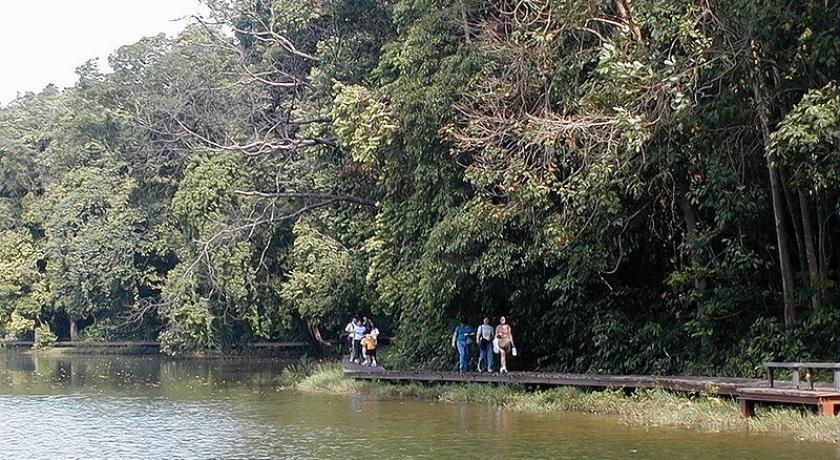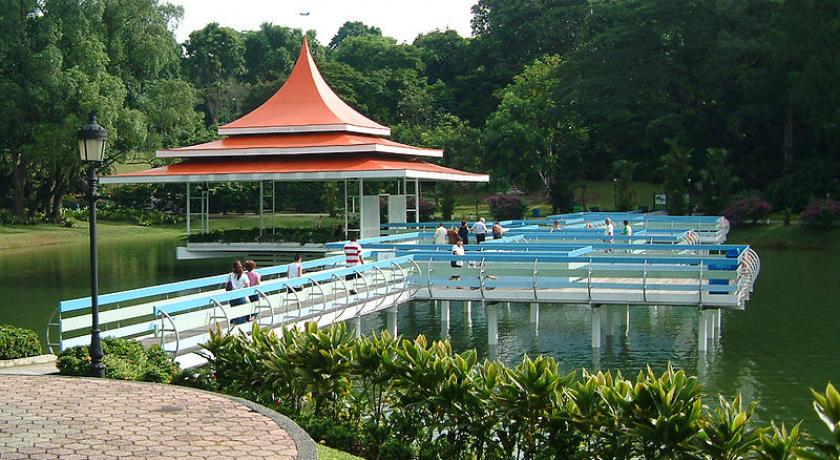Description
MacRitchie Reservoir is Singapore's oldest reservoir. The reservoir was completed in 1868 by impounding water from an earth embankment, and was then known as the Impounding Reservoir or Thomson Reservoir.
History
Before the early 19th century, most of the main island of Singapore was covered with primary forest. Soon after the British established a settlement in Singapore in 1819 and commercial activity took root, there was a demand for fresh water. However, it was decades before the settlement's first fresh water supply was established.
Between 1820 and 1870, a substantial portion of the virgin forest was cleared to assist Singapore in becoming an important trading post. Prior to this, Chinese planters had also worked the forested land for timber and the cultivation of crops like gambier, pepper and rubber (rubber was not planted commercially in Singapore before the 20th century). By 1886, only 10% of the original forest cover remained.
In 1823, British Resident John Crawfurd proposed the building of a reservoir and waterworks, setting aside $1,000 for these plans but nothing came of them. Another plan that ended up in smoke was the idea to tap the headwaters of Singapore Creek, now known as the Singapore River.
Finally, in 1857, Straits Chinese merchant Tan Kim Seng donated $13,000 for the improvement of the town's waterworks but delays, poor planning and use of the wrong building materials ate into the budget. New plans were drawn up for an impounding reservoir in Thomson. Tan's money was insufficient – the cost of the new reservoir was $100,000 – but colonial headquarters in Calcutta refused to make up the rest of the cost. When Tan died in 1864, the reservoir was no nearer completion.
Construction was eventually completed in 1868 but the pumps and distributing network were not finished until 1877. By this time, public confidence in the government's ability was dented.
In 1882, in a move to salvage its reputation, the Municipal Council erected a fountain in Fullerton Square in honour of Tan Kim Seng. The fountain was later moved to Queen Elizabeth Walk, where it stands today.
In 1891, the holding capacity of the Impounding Reservoir or Thomson Reservoir, named after its designer John Turnbull Thomson, was expanded to over 465 million imperial gallons (2,110,000 m3). Municipal Engineer James MacRitchie oversaw this $32,000 expansion and the reservoir was named after him in 1922. In the 1890s, he had urged the government to buy the Chasseriau Estate for use as a reservoir but it was not until much later that the purchase was made.
However, the reservoir's 4 million imperial gallons (18,000 m3) a day was still insufficient to meet demand. Water was pumped into the reservoir from the upper section of Kallang River, one of the island's bigger sources of fresh water. Other fresh water supplies – Lower Peirce Reservoir and Seletar Reservoir – were completed in 1912 and 1920 respectively. However, the government realised that Singapore would not be able to meet its own fresh water needs. In 1927, a water treaty was signed with the Sultan of Johor and Singapore started receiving water from Johor in 1932.
The construction of MacRitchie Reservoir brought deforestation around the area to a halt. The forest surrounding the reservoir has been protected as a water catchment reserve. The forested areas surrounding the other two reservoirs, Peirce Reservoir and Upper Seletar Reservoir (formerly Seletar Reservoir) were also protected when these reservoirs were developed.
During World War II, during the Japanese Occupation of Singapore the Japanese Imperial Army built a Shinto Shrine, Syonan Jinja in the middle of the forest surrounding MacRitchie Reservoir. When the British forces re-occupied Singapore, the Shrine was destroyed. However, ruins of the shrine remain and serve as a quaint piece of history accessible only to those willing to look for it, given its obscure location. The National Heritage Board declared the site a Historic Site in 2002, although no plans have been made public to develop or to protect the site.
Present
More than one square kilometer of primary forest still flourishes in the Central Catchment Nature Reserve today, particularly around MacRitchie Reservoir. Rubber trees, remnants of the plantations from the 19th century, can still be seen along the fringes of the reservoir.
There are boardwalks skirting the edge of the scenic MacRitchie Reservoir and walking trails through the forest. They range in distances from 3 km to 11 km. Interpretative signboards along the boardwalks allow for a self-guided tour along the fringes of the MacRitchie forest.
The boardwalk around the perimeter of the MacRitchie Reservoir brings the visitor through interesting secondary forest in the Central Catchment nature area. The boardwalk which hugs the reservoir also allows for easy exploration of freshwater wildlife. The Ant plant (Macaranga bancana.) and pitcher plants are common in the area.
In addition to the boardwalk, another popular attraction is the HSBC TreeTop Walk, a 250 m aerial free standing suspension bridge spanning Bukit Peirce and Bukit Kalang which are the two highest points in MacRitchie. The bridge was completed in July 2004, and the TreeTop Walk was officially launched on 5 November 2004. The structure, which is 25 m at its highest point, offers visitors a panoramic view of Upper Peirce Reservoir and the surrounding lush rainforest. Jelutong Tower also offers a view of the Singapore Island Country Club golf course and the MacRitchie Reservoir.
The 3.2 km and 4.8 km trails are still used as cross-country running routes for various inter-school competitions today.
Schools can be seen using the reservoir as a place for water sports such as canoeing and kayaking. There are certain competitions held there annually.
Source https://en.wikipedia.org/wiki/MacRitchie_Reservoir
Address
Singapore
Singapore
Lat: 1.344762087 - Lng: 103.822349548






